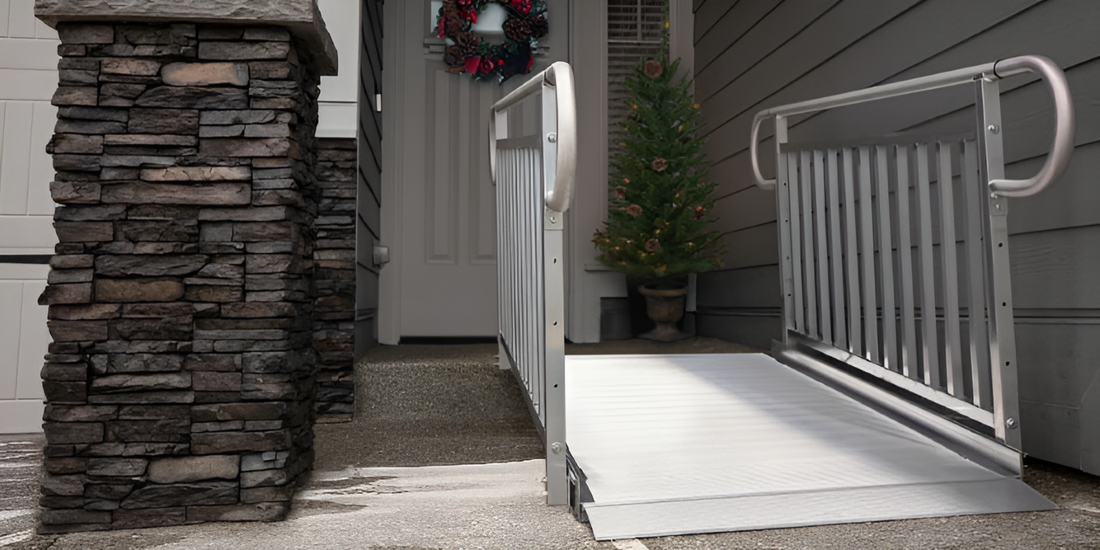As temperatures drop across the country, it’s important to ensure your residential ramp is prepared to handle the rigors of winter. Cold weather, snow, and ice can pose serious risks to accessibility and safety, especially for individuals who rely on ramps for mobility. Taking the proper steps to maintain your ramp—whether it’s made of concrete, wood, or aluminum—can make all the difference in avoiding accidents and ensuring a smooth and safe transition in and out of your home.
In this blog post, we’ll provide a comprehensive guide on maintaining your ramp during the colder months, depending on its material.
Concrete Ramps
Concrete ramps are relatively easy to maintain, as they can be treated much like a sidewalk. Snow should be shoveled off the surface regularly to prevent buildup, and ice melt or salt can be applied to reduce slick conditions. However, there’s a major consideration to keep in mind—concrete expands and contracts with fluctuating temperatures. This process, called thermal expansion, can lead to cracking if not properly addressed. It’s important to inspect your concrete ramp for any existing cracks before winter arrives and repair them promptly to avoid worsening damage caused by freezing and thawing cycles.
In addition to monitoring for cracks, using proper ice melt is key. While salt can effectively reduce ice, it can also degrade the concrete over time, leading to pitting or further cracks. Opting for gentler deicing agents like Magnesium Chloride is a safer choice for concrete surfaces as it’s less corrosive and minimizes damage to your ramp’s structure.
Wood Ramps
Wood ramps require more ongoing care throughout the year, and winter is no exception. One of the primary concerns with wooden ramps is moisture absorption, which can lead to warping, rotting, and deterioration of the materials. To combat this, it’s essential to seal your wooden ramp before the winter months arrive. Applying a high-quality, weather-resistant sealant will help prevent water from seeping into the wood and causing long-term damage.
However, sealing the wood is only part of the equation. Wooden ramps can become dangerously slippery when snow and ice accumulate. Applying grip tape to the surface of your ramp can enhance traction and make it safer to use, especially in wet or icy conditions. But keep in mind that grip tape can wear out over time, especially with heavy use. Check the tape regularly to ensure it hasn’t peeled or deteriorated, and replace it as needed to help prevent slipping hazards.
Along with maintaining the grip tape, it’s crucial to keep your wood ramp clear of snow, ice, and debris. You can use a shovel to remove snow, but be gentle to avoid scratching the surface. Just like with concrete, avoid using harsh chemicals or rock salt that can damage the wood. Instead, opt for environmentally friendly, non-corrosive ice melt products.
Aluminum Ramps
Aluminum ramps, such as those from EZ-ACCESS®, are the most durable and low-maintenance option when it comes to cold weather upkeep. These ramps are designed to resist rust and corrosion, making them ideal for areas that experience harsh winters. To maintain an aluminum ramp, use a plastic shovel or broom to remove snow and ice. It’s important to avoid metal shovels, which can scratch or dent the surface.
Unlike wood and concrete, aluminum doesn’t absorb water or expand and contract with temperature changes, which means it requires far less maintenance. However, to keep the ramp surface safe and slip-resistant, we recommend using Magnesium Chloride as an ice-melt solution. This substance is gentle on metal surfaces and won’t cause the corrosion or damage that traditional salts might.
Another benefit of aluminum ramps is their built-in tread, which helps maintain traction even in icy conditions. Many aluminum ramps are designed with slip-resistant surfaces, so they naturally provide better grip compared to wood or concrete ramps. Despite this, it’s still important to keep the ramp free of snow and ice to ensure maximum safety.
Additional Winter Safety Tips for All Ramp Types
Regardless of the material your ramp is made from, there are a few additional safety steps to take during the winter months:
- Routine Inspections: Check your ramp regularly for any signs of damage, wear, or slippery areas. Even small issues can escalate in freezing temperatures, so addressing problems early can help prevent accidents.
- Handrails and Lighting: Make sure handrails are sturdy and easy to grip, as they provide crucial support for those using the ramp in icy or snowy conditions. Additionally, proper lighting is essential for visibility during the darker winter months, especially when navigating snow-covered surfaces.
- Clearing Pathways: Keep the areas leading to and from the ramp free from snow and ice. It’s important to create a safe, accessible path not only on the ramp itself but also on the surrounding walkways and driveways.
By following these maintenance tips, you can ensure your ramp stays safe and functional throughout the winter. For homeowners looking for an access solution that requires minimal upkeep, consider investing in a high-quality aluminum ramp from EZ-ACCESS, which is designed to withstand the harshest conditions while providing safe, reliable access year-round.
Stay safe, stay prepared, and enjoy peace of mind knowing your ramp is ready for winter!

